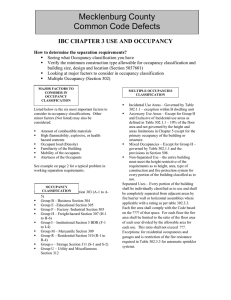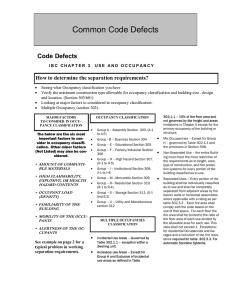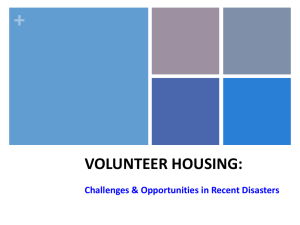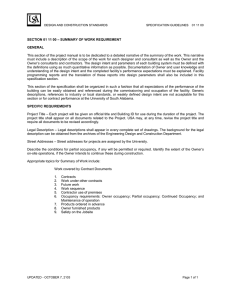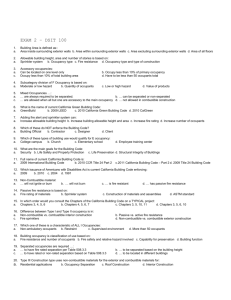occupancy classification
advertisement
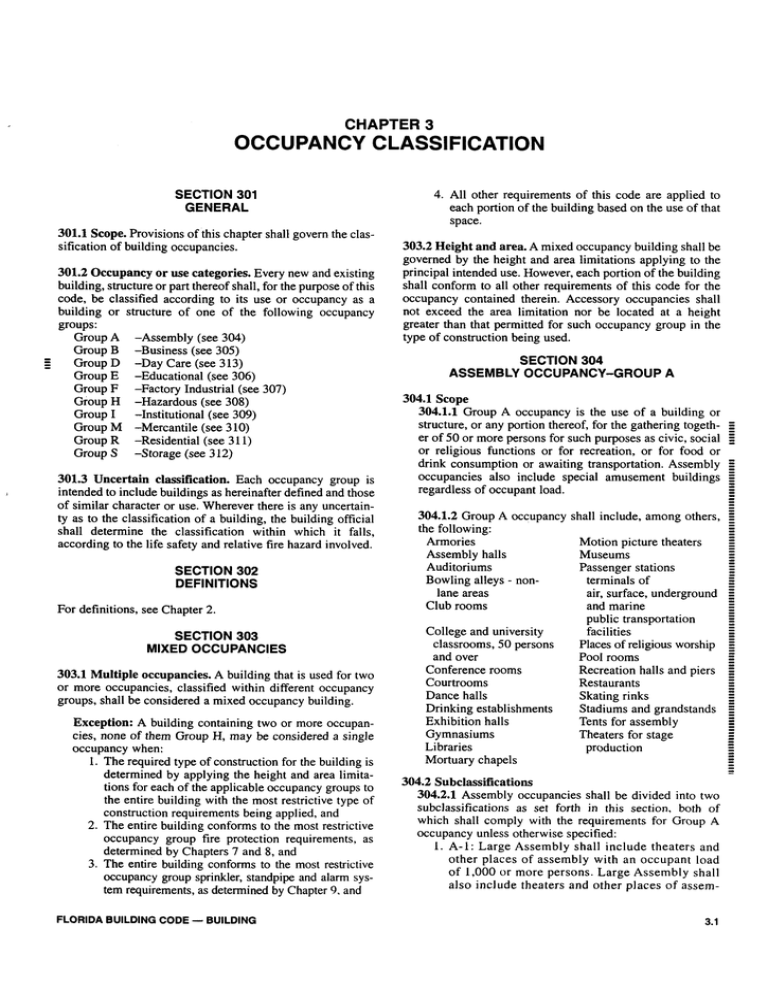
CHAPTER 3 OCCUPANCY CLASSIFICATION SECTION 301 GENERAL 301.1 Scope. Provisions of this chapter shall govern the classification of building occupancies. 301.2 Occupancy or use categories. Every new and existing building, structure or part thereof shall, for the purpose of this code, be classified according to its use or occupancy as a building or structure of one of the following occupancy groups: Group A -Assembly (see 304) Group B -Business (see 305) Group D -Day Care (see 313) Group E -Educational (see 306) Group F -Factory Industrial (see 307) Group H -Hazardous (see 308) Group I -Institutional (see 309) Group M -Mercantile (see 310) Group R -Residential (see 311) Group S -Storage (see 312) 301.3 Uncertain classification. Each occupancy group is intended to include buildings as hereinafter defined and those of similar character or use. Wherever there is any uncertainty as to the classification of a building, the building official shall determine the classification within which it falls, according to the life safety and relative fire hazard involved. SECTION 302 DEFINITIONS For definitions, see Chapter 2. SECTION 303 MIXED OCCUPANCIES 303.1 Multiple occupancies. A building that is used for two or more occupancies, classified within different occupancy groups, shall be considered a mixed occupancy building. Exception: A building containing two or more occupancies, none of them Group H, may be considered a single occupancy when: 1. The required type of construction for the building is determined by applying the height and area limitations for each of the applicable occupancy groups to the entire building with the most restrictive type of construction requirements being applied, and 2. The entire building conforms to the most restrictive occupancy group fire protection requirements, as determined by Chapters 7 and 8, and 3. The entire building conforms to the most restrictive occupancy group sprinkler, standpipe and alarm system requirements, as determined by Chapter 9, and FLORIDA BUILDING CODE — BUILDING 4. All other requirements of this code are applied to each portion of the building based on the use of that space. 303.2 Height and area. A mixed occupancy building shall be governed by the height and area limitations applying to the principal intended use. However, each portion of the building shall conform to all other requirements of this code for the occupancy contained therein. Accessory occupancies shall not exceed the area limitation nor be located at a height greater than that permitted for such occupancy group in the type of construction being used. SECTION 304 ASSEMBLY OCCUPANCY-GROUP A 304.1 Scope 304.1.1 Group A occupancy is the use of a building or structure, or any portion thereof, for the gathering together of 50 or more persons for such purposes as civic, social or religious functions or for recreation, or for food or drink consumption or awaiting transportation. Assembly occupancies also include special amusement buildings regardless of occupant load. 304.1.2 Group A occupancy shall include, among others, the following: Armories Motion picture theaters Assembly halls Museums Auditoriums Passenger stations Bowling alleys - nonterminals of lane areas air, surface, underground Club rooms and marine public transportation College and university facilities classrooms, 50 persons Places of religious worship and over Pool rooms Conference rooms Recreation halls and piers Courtrooms Restaurants Dance halls Skating rinks Drinking establishments Stadiums and grandstands Exhibition halls Tents for assembly Gymnasiums Theaters for stage Libraries production Mortuary chapels 304.2 Subclassifications 304.2.1 Assembly occupancies shall be divided into two subclassifications as set forth in this section, both of which shall comply with the requirements for Group A occupancy unless otherwise specified: 1. A-l: Large Assembly shall include theaters and other places of assembly with an occupant load of 1,000 or more persons. Large Assembly shall also include theaters and other places of assem3.1 304.2.2-307.1.2 bly with a stage requiring proscenium opening protection and with an occupant load of 700 or more persons. 2. A-2: Small Assembly shall include theaters and other places of assembly with or without a stage requiring proscenium opening protection and with an occupant load of 50 or more persons, but with an occupant load less than designated for Large Assembly. 304.2.2 Occupancy of any room or space for assembly purposes by fewer than 50 persons in a building or other occupancy and incidental to such other occupancy shall be classified as part of the other occupancy and shall be subject to the provisions applicable thereto. 304.2.3 Restaurants and drinking establishments not located within another occupancy with an occupant load of less than 50 persons shall be classified as Group M, Mercantile. SECTION 305 BUSINESS OCCUPANCY - GROUP B 305.1 Scope. 305.1.1 Group B occupancy is the use of a building or structure, or any portion thereof, for office, professional, or service type transactions including normal accessory storage and the keeping of records and accounts. 305.1.2 Group B occupancy shall include, among others, the following: Air traffic control towers Electronic data processing (ARCTs) areas Animal hospitals, kennels, Florists and nurseries pounds General post offices Automobile and other Greenhouses motor vehicle showrooms Laboratories; testing and Automobile or other vehicle research (nonhazardous) service stations Laundries; pickup and Banks delivery stations and Barber shops self-service Beauty shops Bowling alleys-lane areas Carwashes Office buildings City Halls Outpatient clinics, Civic administration areas ambulatory Clinics - outpatient Police stations College and university Print shops instructional buildings, Professional services; classrooms, under 50 attorney, dentists, persons, and instructional physician, engineer, etc. laboratories Radio and television Courthouses stations Dry cleaning; pick-up and Telephone exchanges delivery stations and Town halls self service Educational occupancies above the 12th grade 3.2 305.1.3 Occupancy of any room or space for assembly purposes by fewer than 50 persons in a building or other occupancy and incidental to such other occupancy shall be classified as part of the other occupancy and shall be subject to the provisions applicable thereto. Exception: Provisions of 403.1.3.4, 403.2, 403.3, 1019.10, 1019.11 and 3103 shall apply to buildings used for assembly purposes, regardless of occupant load. 305.1.4 Dry cleaning establishments using solvents which are nonflammable or nonflammable at ordinary temperatures and only moderately flammable at higher temperatures (Class IV System) shall be classified as Group B occupancy. 305.1.5 Sections 423(1) and (2) are applicable to State University Systems. SECTION 306 EDUCATIONAL OCCUPANCY-GROUP E 306.1 Scope. 306.1.1 Group E occupancy is the use of a building or structure, or any portion thereof, by six or more persons at any one time for educational purposes through the 12th grade. 306.1.2 Child care facilities which accommodate 4 or more children of any age who stay less than 24 hours per day shall be classified as Group D. 306.1.3 Parts of buildings used for the congregating or gathering of 50 or more persons in one room shall be classified as Group A occupancy, regardless of whether or not such gathering is of an educational or instructional nature. 306.1.4 Schools for business or vocational training shall be classified in the same occupancies and conform to the same requirements as the trade, vocation or business taught, provided the concentration of persons will not exceed that listed in 1003 for the occupancy classification used. 306.1.5 Public Education Occupancies shall comply with section 423. SECTION 307 FACTORY-INDUSTRIAL OCCUPANCY-GROUP F 307.1 Scope 307.1.1 Group F occupancy is use of a building or structure, or any portion thereof, for assembling, disassembling, repairing, fabricating, finishing, manufacturing, packaging or processing operations that are not otherwise classified in this code. 307.1.2 Group F occupancy shall include, among others, the occupancies listed in this section, but does not include buildings used principally for any purpose involving highly combustible, flammable or explosive products or materials(See 308.) FLORIDA BUILDING CODE — BUILDING 307.1.3-308.2.1 Assembly Plant Factory Manufacturing Plant Mill Processing Plant 307.1.3 Group F Special Purpose Factory-Industrial occupancy includes industrial operations in buildings designed for and suitable only for particular types of operations, characterized by a relatively low density of employee population, with much of the area occupied by machinery or equipment. Group F Special Purpose Factory-Industrial occupancy shall include, among others, the occupancies listed in this section. Steel Mills Paper Plant Generating Plant 307.1.4 Portions of Group F occupancy involving highly combustible, flammable or explosive products or materials shall be properly ventilated, protected and separated from the remainder of the building in accordance with the appropriate NFPA Standard or the entire building will be classified as Hazardous occupancy. (See 308.) SECTION 308 HAZARDOUS OCCUPANCY-GROUP H 308.1 Scope. Group H occupancy is the principal use of a building or structure, or any portion thereof, that involves the manufacturing, processing, generation, storage or other use of hazardous materials in excess of the exempt quantities listed in this section. 308.2 Subclassification 308.2.1 Group H hazardous occupancies shall be divided into H1 through H4 according to the hazards presented by each material as described below: H1: Buildings or parts thereof used for the manufacturing, processing, generation or storage of materials which present a detonation hazard. Detonation hazards include explosives, blasting agents, pyrotechnic special effect materials, display fireworks, 1.3G, (Class B, Special) and consumer fireworks, 1.4G, (Class C, Common) manufacturing, Class 4 liquid and solid oxidizers, unclassified detonatable organic peroxides, and Class 3 and 4 detonatable unstable (reactive) materials in excess of the amounts given in Table 308.2A. H2: Buildings or parts thereof used for the manufacturing, processing, generation or storage of materials which present a deflagration hazard or a hazard from accelerated burning. Deflagration hazards include Class I, II and III-A flammable or combustible liquids in open containers or containers pressurized at more than 15 psi (103 kPa), combustible dusts stored in piles or within open containers, Class 3 liquid and solid oxidizers, Class I organic peroxides, solid, liquid and gaseous pyrophorics, Class 3 nondetonatable unstable (reactive) materials and flammable cryogenic fluids in excess of the amounts given in Table 308.2B. H3: Buildings or parts thereof used for the manufacturFLORIDA BUILDING CODE — BUILDING ing, processing, generation or storage of materials which readily support combustion or present a physical hazard. Physical hazards include storage of consumer fireworks, 1.4G, (Class C, Common) except at fireworks manufacturing plants; Class I, II and III flammable and combustible liquids in closed containers pressurized at 15 psi (103 kPa) or less; Level 2 and Level 3 aerosol products;, flammable solids; Class 1 and 2 liquid and solid oxidizers; Class II, III or IV organic peroxides; Class 1 and 2 unstable (reactive) materials; water reactive materials and oxidizing cryogenic fluids in excess of the amounts given in Table 308.2C. H4: Buildings or parts thereof used for the manufacturing, processing, generation or storage of materials which are health hazards. Health hazards include highly toxic and toxic compressed gases, highly toxic and toxic solids and liquids, corrosives, irritants, sensitizers, and other health hazard solids, liquids and gases in excess of the amounts given in Table 308.2D. Exceptions to 308.2.1: 1. The quantities of alcoholic beverages in retail sales uses are unlimited provided the liquids are packaged in individual containers not exceeding 1 gal (3.79 L). 2. The quantities of medicines, foodstuffs and cosmetics containing not more than 50 percent by volume of water-miscible flammable liquids and with the remainder of the solution not being flammable are unlimited when packaged in containers not exceeding 1 gal (3.79 L). 3. Mercantile occupancies: Storage of flammable and combustible liquids shall be limited to quantities needed for display and normal merchandising purposes but shall not exceed the quantities permitted in the Florida Fire Prevention Code. 4. Mercantile occupancies offering for retail sale sparklers, novelties and trick noisemakers as defined at Section 791.01, Florida Statutes, and that are not defined as fireworks by Chapter 791, Florida Statutes. Storage of sparklers and other novelties or trick noisemakers as defined in Chapter 791, Florida Statutes, within Mercantile Occupancies shall be in accordance with Section 791.055, Florida Statutes. 5. Explosives, blasting agents and ammunition preempted by the requirements of the Florida Fire Prevention Code. 6. Refrigeration systems. 7. Storage, use and handling of pesticides and agricultural materials used for weed abatement, pest control, erosion control, soil amendments or similar application for use on the premises. 8. Materials contained within fuel tanks or batteries on automobiles. 9. Stationary batteries used for facility emergency power, uninterrupted power supply or telecommunication facilities, provided that the batteries are provided with safety venting caps and sufficient ventilation to produce a vapor-air mixture which is less than 25 percent of the lower explosive limit. 3.3 308.2.2 - 308.2.4 10. Control areas in accordance with 308.2.2. 11. Corrosives, irritants and sensitizers shall not include commonly used building materials. 12. Corrosives, irritants and sensitizers shall not include personal or household products in their original packaging for retail display. 13. Level 1 aerosol products shall be considered equivalent to a Class III commodity, as defined by NFPA 30B and the Florida Fire Prevention Code. 14. Buildings and structures and associated equipment used for compression, storage and dispensing of compressed natural gas (CNG) that conform to 407.18 and defined as outdoors. 15. A maximum quantity of 200 lb (91 kg) of solid or 20 gal (76 L) of liquid Class 3 oxidizers shall be permitted when such materials are necessary for maintenance purposes, or for operation or sanitation of equipment. Storage containers and conditions shall be as required by the Florida Fire Prevention Code. 308.2.2 Control areas containing hazardous material not exceeding the exempt quantities shall be permitted in all occupancies except assembly occupancies. The control area shall be separated by 1-hour fire resistant construction with 3/4-hour opening protection with a self-closing or automatic closing device in accordance with 705.1.3.2.3. The maximum number of control areas per floor in multistory buildings shall be limited to four. The maximum number of control areas in any building shall be limited to ten. When control areas are on different floors but adjacent to each other, the floor/ceiling between these control areas shall have not less than 2-hour fire resistant construction. When the floor/ceiling assembly forms part of the separation, the separation walls of the control area shall extend from the floor below to the floor deck above. 308.2.3 When the stored amount of any hazardous material listed in Tables 308.2A through 308.2D is exceeded in any one control area, such storage shall be within a room or building conforming to the code requirements for H1, H2, H3 or H4 occupancies. 308.2.4 Multiple Hazards. Materials representing hazards that are classified in one or more of the H occupancy subgroups shall conform to the code requirements for each of the use groups represented. 3.4 FLORIDA BUILDING CODE — BUILDING TABLE 308.2A - TABLE 308.2B TABLE 308.2A EXEMPT QUANTITIES OF H1 MATERIALS EXPLOSIVES AND BLASTING AGENTS1,6 UNSTABLE (REACTIVE) MATERIALS (DETONATABLE)2,5 CLASS 3 CLASS 4 Solids (lb) Liquids (gal) LIQUID AND SOLID OXIDIZERS2,3,4 (lb) CLASS 4 unprotected by sprinklers or cabinet 0 0 0 0 5 50 0 0 w i t h i n cabinet i n unsprinklered building 0 0 0 0 10 100 0 0 i n sprinklered b u i l d i n g , not i n cabinet 1 0.10 1 1 10 100 1 10 i n sprinklered building, within cabinet 2 0.20 2 2 20 200 2 20 CONDITIONS ORGANIC PEROXIDES2,5 (lb) UD Solids & Liquids (lb) Gases (cu ft) Solids & Liquids (lb) Gases (cu ft) For SI: 1 lb = 0.4536 kg, 1 gal = 3.7854 L, 1 cu ft = 0.02832 m3. UD = Unclassified Detonatable. Notes: 1. Storage of pyrotechnic special effect materials in motion picture, television, theatrical and group entertainment production when under permit amount as specified in.the Florida Fire Prevention Code. 2. A conversion of 10 lb/gal shall be used. 3. No exempt amounts are permitted in Group A, E, M, or R or offices of Group B occupancies. 4. No exempt amounts are permitted in Group I occupancies or in classrooms or laboratories of Group B unless storage is within a hazardous material storage cabinet containing no other storage. 5. Except for laboratories in Group B occupancies, materials are not permitted in Group A, B, E, I, M and R occupancies. 6. Allowable quantities for retail display and storage are specified in the Florida Fire Prevention Code. TABLE 308.2B EXEMPT QUANTITIES OF H2 MATERIALS CONDITIONS FLAMMABLE AND COMBUSTIBLE LIQUIDS IN OPEN CONTAINERS OR CONTAINERS PRESSURIZED AT MORE THAN 15 pslg (gal)1 Class 2 IA IB IA II IC IB2 IC2 IIIA COMBUSTIBLE DUSTS STORED IN PILES OR OPEN CONTAINERS (lb) LIQUID AND SOLID OXIDIZERS (lb)3,4 ORGANIC PEROXIDES (lb)3,5 UNSTABLE REACTIVES5 (NONDETONATABLE) PYROPHORIC MATERIALS2,5 CLASS 3 Class 3 Class 1 Solid & Liquid Gases (cu ft) (lb) Solid & Liquid (lb) Gases (cu ft) Cryogenic Fluids (gal) unprotected by sprinklers or cabinet 30 60 90 120 120 330 125 10 5 0 0 5 50 45 within cabinet in unsprinklered building 60 120 180 240 240 660 250 20 10 0 0 10 100 45 in sprinklered building, not in cabinet 60 120 180 240 240 660 250 20 10 4 50 10 100 90 in sprinklered building, within cabinet 120 240 360 480 480 1,320 500 40 20 8 100 20 200 90 For SI: 1 lb = 0.4536 kg, 1 gal = 3.7854 L, 1 cu ft = 0.02832 m3. Notes: 1. For storage requirements see the Florida Fire Prevention Code. 2. Containing not more than the exempt amounts of Class IA, IB, IC flammable liquids. 3. A conversion of 10 lb/gal shall be used. 4. A maximum quantity of 200 lb of solid or 20 gallons may be permitted in I, M and R occupancies when necessary for maintenance purposes or operation of equipment. FLORIDA BUILDING CODE — BUILDING 3.5 TABLE 308.2C • 308.2D TABLE 308.2C EXEMPT QUANTITIES OF H3 MATERIALS CONDITIONS IA FLAMMABLE AND COMBUSTIBLE LIQUIDS IN CLOSED CONTAINERS PRESSURIZED AT15pslg OR LESS (gal)1 CLASS IB IC IA2 IIIA II IB2 IC2 IIIB Liquid&Solid Oxidizers (lb)3 CLASS 1 2 Flammable Solids (lb)4 3 Organic Peroxides (lb) CLASS III IV II Water UNSTABLE MATERIALS3 Class 2 Reactive3 Claas 1 Solid & Solid 1 Liquid Gases CLASS Liquid Gases (cu ft) (lb) (cu ft) 1 2 1 Flammable Or Oxidizing Cryogenic Fluids (gal) 750 50 250 N L 50 1.000 250 1.500 100 500 N L 100 10 45 250 1.000 250 1,500 100 500 N L 100 10 90 500 2.000 500 3.000 200 2.000 N L 200 20 90 unprotected by sprinklers or cabinet 30 60 90 120 120 330 13.200 125 1.000 250 50 125 500 within cabinet in unsprinklered building 60 120 180 240 240 660 26.400 250 2.000 500 100 250 in sprinklered building, not in cabinet 60 120 I80 240 240 660 NL 250 2,000 500 100 in sprinklered building, within cabinet 120 240 360 480 480 1,320 NL 500 4,000 1.000 200 125 5 45 For SI: 1 lb = 0.4536 kg, 1 gal = 3.7854 L, 1 cu ft = 0.02832 m3. Notes: 1. For storage requirements see of the Florida Fire Prevention Code. 2. Containing not more than the exempt amounts of Class IA. IB or 1C flammable liquids. 3. A conversion of 10 lb/gal shall be used. 4. For baled combustible fibers the exempt quantities shall be 1.000 cu ft. 2.000 cu ft, 2,000 cu ft and 4.000 cu ft for the respective conditions. TABLE 308.2D EXEMPT QUANTITIES OF H4 MATERIALS5 HIGHLY TOXIC AND TOXIC SOLIDS AND LIQUID3 (lb) CORROSIVES, IRRITANTS, SENSITIZERS, AND HEALTH HAZARD SOLIDS, LIQUIDS, AND GASES HIGHLY TOXIC GASES1,2 (cu ft) TOXIC COMPRESSED GASES1,2,4 (cu ft) Highly Toxic Toxic Solids (lb) Liquids (gal) Gases (cu ft) unprotected by sprinklers or cabinets 0 650 1 500 5,000 500 650 within cabinet in unsprinklered building 20 1.300 2 1.000 10.000 1.000 1.300 in sprinklered building, not in cabinet 0 1.300 2 1.000 10,000 1.000 1.300 in sprinklered building, within cabinet 40 2.600 4 2,000 20,000 2,000 2,600 CONDITIONS For SI: 1 lb = 0.4536 kg. 1 gal = 3.7854 L, 1 cu ft = 0.02832 m3. Notes: 1. No exempt amounts are permitted in Group A, M. R and offices in Group B occupancies. 2. Except for cylinders not exceeding 20 cu ft stored within a gas storage cabinet or fume hood, no exempt amounts are permitted in Group E or I occupancies or in classrooms. 3. A conversion of 10 lb/gal shall be used. 4. Compressed chlorine gas shall have an exempt amount of 810 cu ft. 5. Except for laboratories in Group B occupancies, material is not permitted in Group A. B, E, I. M and R occupancies. 3.6 FLORIDA BUILDING CODE — BUILDING 309-312.2.2 SECTION 309 INSTITUTIONAL OCCUPANCY - GROUP I 309.1 Group I Unrestrained Occupancy. Group I Unrestrained includes buildings or portions thereof used for medical, surgical, psychiatric, nursing or custodial care on a 24 hour basis of 4 or more persons who are not capable of self-preservation and shall include among others: Detoxification facilities Hospitals Mental hospitals Nursing homes (both intermediate care facilities and skilled nursing facilities). Facilities such as the above with 3 or fewer persons not ancillary to other uses shall be classified as a residential occupancy. 309.2 Group I Restrained Occupancy. Group I Restrained includes buildings or portions thereof which provide sleeping accommodations for four or more persons under some degree of restraint or security who are generally incapable of selfpreservation because of security measures not under the occupant's control and shall include among others: Correctional institutions Detention centers Jails Reformatories Exception: Group I Restrained qualifying for Use Condition 1 may be classified as a Group R occupancy. SECTION 310 MERCANTILE OCCUPANCY–GROUP M 310.1 Scope. Group M occupancy is the use of a building or structure or any portion thereof, for the display and sale of merchandise including stocks of goods, wares or merchandise incidental to such purposes and accessible to the public and shall include, among others, the following: Department stores Drug stores Markets Retail stores Sales rooms Shopping centers Wholesale stores (other than warehouses) Restaurants and drinking establishments not located within another occupancy with an occupant load of less than 50 persons. SECTION 311 RESIDENTIAL OCCUPANCY-GROUP R 311.1 Scope. Group R occupancy is the use of a building or structure, or any portion thereof, for sleeping accommodations not classed as a Group I occupancy. 311.2 Subclassifications. Group R occupancies shall include, among others, the following: Rl: Residential occupancies where the occupants are primarily transient in nature including: Boarding housing (transient) Hotels Motels R2: Multiple dwellings where the occupants are primarily permanent in nature, including: Apartment houses Convents Dormitory facilities which accommodate 6 or more persons of more than 2 1 / 2 years of age who stay more than 24 hours. Fraternities and sororities Monasteries Rooming houses (not transient) R3: Residential occupancies including the following: Child care facilities which accommodate 3 or fewer children of any age for any time period. One- and two-family dwellings where the occupants are primarily permanent in nature and not classified as Rl, R2 or I. Rooming houses (transient) Rectories, parsonages R4: Residential Care/Assisted Living Facilities housing 6 or more occupants on a 24-hour basis; these occupancies include the following: Alcohol and drug abuse centers Assisted living facilities Congregate care facilities Convalescent facilities Halfway houses Group homes Residential board and care facilities Social rehabilitation facilities SECTION 312 STORAGE OCCUPANCY-GROUP S 312.1 Scope. Group S occupancy is the principal use of a building or structure, or any portion thereof, for storage that is not classed as a Group H occupancy, including buildings or structures used for the purpose of sheltering animals. For buildings used for the storage of hazardous materials, see 308. 312.2 Subclassifications 312.2.1 S1 Ordinary Hazard Storage shall include buildings used for the storage of combustible materials when not classified as S2 Low Hazard or Group H. 312.2.2 S2 Low Hazard Storage shall include buildings used for the storage of noncombustible materials such as products on wood pallets or in paper cartons without sig- FLORIDA BUILDING CODE — BUILDING 3.7 312.2.3-313.2.4 nificant amounts of combustible wrappings. Such products may have a negligible amount of plastic trim such as knobs, handles or film wrapping. S2 Low Hazard Storage shall include, but not be limited to, the following: Beer or wine up to 12% alcohol in metal, glass or ceramic containers Cement in bags Dairy products in nonwax-coated paper containers Dry cell batteries Dry insecticides Electrical motors Electric coils Empty cans Electrical insulators Fresh fruit and vegetables in nonplastic trays or containers Frozen foods Foods in noncombustible containers Glass bottles, empty or filled with noncombustible liquids Gypsum board Inert pigments Meats Metal cabinets Metal desks with plastic tops and trim Metal parts Mirrors Oil-filled and other types of distribution transformers Washers and dryers Stoves 312.2.3 Portions of Group S occupancy involving highly combustible, flammable or explosive products or materials shall be properly ventilated, protected and separated from the remainder of the building in accordance with the appropriate NFPA Standard or the entire building will be classified as Group H occupancy. 313.2.1 Family Day-Care Home. A family day-care home is a day-care home in which more than 3 but fewer than 7 clients receive care, maintenance and supervision by other than their relative(s) or legal guardian(s) for less than 24 hr per day with no more than 2 clients incapable of self-preservation. 313.2.2 Group Day-Care Home. A group day-care home is a day-care home in which at least 7 but not more than 12 clients receive care, maintenance, and supervision by other than their relative(s) or legal guardian(s) for less than 24 hr per day with no more than 3 clients incapable of self-preservation. 313.2.3 Adult Day-Care. Adult day-care shall include any building or portion thereof used for less than 24 hr per day to house more than three adults requiring care, maintenance and supervision by other than their relative(s). Clients shall be ambulatory or semi-ambulatory and shall not be bedridden. They shall not exhibit behavior that is harmful to themselves or others. 313.2.4 Group D occupancies. Group D occupancies shall include, among others, the following: Child day-care occupancies Adult day-care occupancies, except where part of a health care occupancy Nursery schools Day-care homes Kindergarten classes that are incidental to a child day-care occupancy In cases where care is incidental to some other occupancy, the section of this code governing such other occupancy shall apply. SECTION 313 DAY-CARE OCCUPANCY - GROUP D 313.1 Scope. Group D occupancy is the use of a building or structure, or any portion thereof, in which 4 or more clients receive care, maintenance and supervision, by other than their relative(s) or legal guardian(s), for less than 24 hours per day. Occupancies that include part-day preschools, kindergartens and other schools whose purpose is primarily educational even though the children are of preschool age shall comply with the provisions for Group E occupancies. 313.2 Subclassifications. Day-care occupancies in which more than 12 clients receive care, maintenance and supervision, by other than their relative(s) or legal guardian(s), for less than 24 hours per day shall be classified as day- care occupancies. Day-care occupancies of 12 or fewer clients shall be classified as day-care homes and shall be divided into classifications as set forth in this section. 3.8 FLORIDA BUILDING CODE — BUILDING
